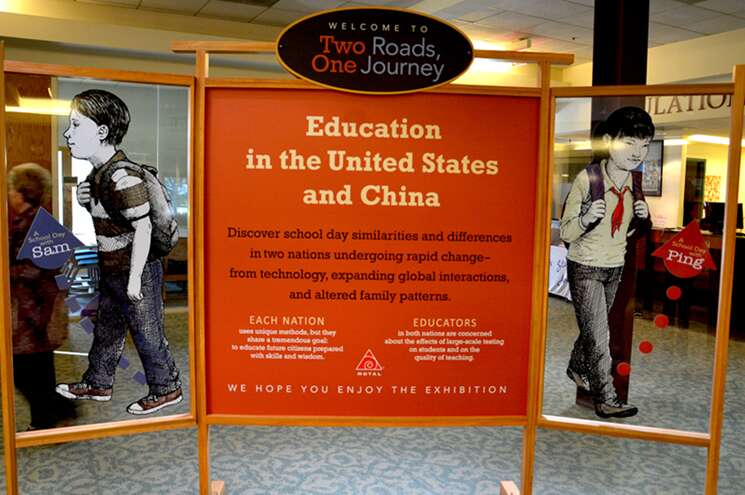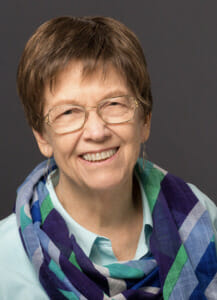A Friendship Rooted in Great Teaching—and a Passion to Honor It

Two Roads, One Journey takes you along on a day in the school life of Ping and Sam, fourth-graders in China and the United States—and though it’s a typical day for both, the experience for visitors is anything but ordinary.
Engaging narratives, multimedia, and hands-on displays put you alongside Ping and Sam, and you share in their successes and challenges. The interactive, self-guided exhibition provides a contrast between East and West that shows how culture influences learning.
For Greta Nagel (PhD, Education, ’92) and Nancy Pine (PhD, Education, ’93), who are the primary architects of the traveling exhibition hosted by the Museum of Teaching and Learning (MOTAL), Two Roads, One Journey was a labor of love. The title could also describe their friendship and creative collaboration.
A CGU Friendship
The lifelong educators met at CGU (then known as Claremont Graduate School) in 1990 while pursuing their PhDs.
“There really was only one university to go to because it was the only one that wasn’t a lockstep program,” said Pine, who was teaching in Pasadena when she returned to her graduate studies on a part-time basis. “One of the great things was the openness and the encouraging of students to bring their professionalism and their ideas into classes, which resulted in a depth of thinking and creative spark not available anywhere else at that time.”
Pine’s primary research focus was semiotics, which involves the interconnection of symbol systems, such as speech and gesture. She organized monthly lunch meetings for colleagues to share their ideas, writing, and data. Though Nagel’s academic pursuits were oriented toward curriculum, she joined in.
“It provided a ‘This is business and pleasure’ opportunity for the group, which deepened friendships,” Nagel said. “I was not studying semiotics, but I thoroughly enjoyed the experience.”

Pine: A Long Relationship with China
Both are accomplished authors, and both cite their time at CGU as influential. Pine, whose interest in China was piqued shortly after earning her undergraduate degree at Earlham College in Indiana, rekindled the pursuit when CGU Professor John Regan (who was also a visiting professor at Nanjing University) invited her and another student to accompany him on a visit. It was December in 1989, just months after the Tiananmen Square massacre.
“A lot of people were critical of us going,” Pine said, “but we were there to do research and also just communicate with people. We spent a week there with John and two more weeks on our own. That was the beginning.”
Over the next three decades, Pine would make many trips to China and reflect on them in writing.
Urged on by friends and colleagues, in 2012 she authored Educating Young Giants, which highlighted the significant differences between schooling in China and the United States. (Her latest book, One in a Billion, is the story of An Wei, an outspoken peasant whose odyssey furnishes insight into the development of modern China.)

Nagel: Pursuing Her Dreams
Nagel is the author of The Tao of Teaching, a popular text about student-centered education methods published in 1994. The book is modeled after the style of the Tao Te Ching, a fundamental text of Taoism. (She followed with The Tao of Parenting in 1998.)
“The symbol of the yin and the yang always intrigued me because I saw that when I was a principal,” Nagel said. “I was using that image when we were having in-service talks about the dual importance of direct instruction and bringing students out. At that time and probably still, people say ‘teacher is a guide by the side.’”
The book is rooted in a class Nagel took at San Diego State, which collaborates with CGU in a joint PhD program. One of her professors asked students to read and declare five goals for the next five years. For Nagel, that included writing a book.
“You’ve got to have a dream in order to have a dream come true,” Nagel said. “When I got to Claremont, the flexibility to be creative and the requirement for me to take a course outside the field to use as a lens for education gave me the opportunity to study Taoism. One of my papers became the foundation for The Tao of Teaching.”
Nagel’s next dream—to share the essential truths of teaching—came in 2002 when she was a professor at Cal State Long Beach. Educational psychology was not a required course, despite the need to understand communication and its psychological underpinnings. She also recognized that school boards and legislators often do not have a solid grasp of what works and what doesn’t in educating a child.
“Our religious footing of Christianity has no platform to respect teachers and honor education the way Confucianism does. The innate respect for teachers and education can come from families, but it doesn’t come as a prevailing philosophical platform for our nation,” Nagel said. “I grew up in Chicago, where museums are wonderful and a way of life for families, so I realized that a museum about education would be a way to put teachers on the map.”
An Unexpected Reunion
The Fullerton, Calif.-based Museum of Teaching and Learning, or MOTAL, opened in 2006 with Horace Mann: Uncommon Visionary for the Common American. In the past 15 years, it has provided an array of mobile exhibitions throughout California and a trove of resources and knowledge on its website.
MOTAL also reunited Pine and Nagel.
“We saw each other at social events over the years,” Pine said, “but in 2012, after Educating Young Giants came out, Greta emailed me and asked, ‘How would you like to collaborate on an exhibition?’ That was the beginning of a lot of time spent together.”
Over the next four years, they collaborated with a small team to produce Two Roads, One Journey, which premiered at the Fullerton Arboretum Museum, followed by the Doheny Campus of Mount Saint Mary’s University. The emergence of COVID-19 in early 2020 forced a hiatus, but MOTAL did not skip a beat. With the assistance of interns from CGU, the museum pivoted to other mediums, including bolstering the website with science activities, podcasts, and messages based on MOTAL exhibitions.
“The interns brought their ideas to us, and their abilities with technology turned out to be quite a boon,” Nagel said. They helped produce two movies, including one on MOTAL’s desegregation exhibition, A Class Action.
One of the interns, Allison Koehler, was selected for a joint project with the Smithsonian Institution’s National Museum of American History to collect artifacts and digital recordings from COVID-19 instructional strategies and commencement ceremonies. Koehler is now director of CGU’s Paul Gray Personal Computing Museum.
Future Plans
Once the COVID cloud lifts, Nagel and Pine would like to find a new venue to host Two Roads, One Journey. The need to improve children’s lives in the classroom is great, and the exhibition can offer insights on how to do so in the East and the West.
“There’s a lot we could learn from each other,” Pine said. “One of the things the Chinese have said again and again is ‘How can we get our kids to be creative after they’ve spent 18 years memorizing textbooks?’ They would like to see more interactive learning.”
What the United States could learn from China, she adds, is how to teach mathematics.
“Numerical thinking is embedded in Chinese culture,” she explained. “So, we have to look at the methods of how they interact and some of the things they do in their schools. For example, they have specialist teachers starting in first grade, including a math teacher.”
Despite the differences in the classroom, she said there is a common thread: “The kids’ enthusiasm is enormous, as is the open curiosity. Kids want to learn.”